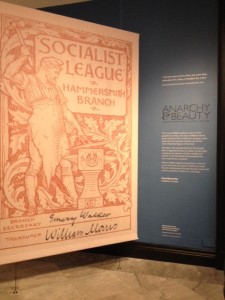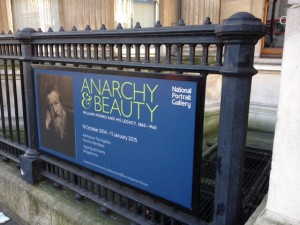Anarchy & Beauty: William Morris and His Legacy, 1860-1960 – National Portrait Gallery, London

If you were in charge of exhibition programming, and you had a passion for a subject which perhaps wasn’t quite right for your museum, what would you do? It’s an interesting question, which could be argued a couple of ways. Is it better to stick to your institution’s core values and strengths, or to push the boat out a bit and do something slightly different? Do you want to appeal to your traditional stakeholders, or bring in a slightly different audience? What to do, what to do…
The exhibition which has brought this question to my mind is one held recently at the National Portrait Gallery, taking as its subject William Morris and his legacy. Variously remembered for his design company, his influence on the Arts & Crafts movement, his socialist lecturing, but perhaps most widely for his wallpapers, Morris is undoubtedly an interesting figure, and one whose legacy in many areas can be seen to this day. The limiting factor comes in staging it at the National Portrait Gallery. Why, you ask? Well, for a couple of reasons. Firstly, Morris didn’t really do portraits himself. Clever interlocking designs, yes. But portraits, no. In fact, he only painted one serious work on canvas, which tends to come out at all he exhibitions, most recently (that I saw) the Pre-Raphaelite show at Tate Britain. And secondly, Morris was so averse to his own image that he didn’t have mirrors in the house, and there are few portraits of him in the exhibition, a nice one by Watts aside.
What, then, you may ask, was on display? It was in fact a pretty interesting assemblage of artworks and artefacts. There were works by the Pre-Raphaelite circle, and works by socialists and suffragettes. There were works by major names in Art & Crafts design, and works by mid-Century artists and artisans of various types. There were artefacts relating to the Garden City movement, and artefacts relating to the 1951 Festival of Britain. And there were portraits of the various personages involved. The trouble that I found was that because the exhibition needed to keep coming back to the idea of the portrait, it felt a little like a collection of people who Morris knew, and people who knew of Morris. As I found the links to be more tenuous towards the end of the show, I went a bit faster and paid a bit less attention than perhaps each artist and designer deserved.
Should they not have done the show then? There is no doubt, first of all, that the curator, Fiona MacCarthy, is passionate about her subject, and the exhibition well researched. In fact, she wrote a biography of Morris some 20 years ago. But was this the right venue? I can’t help but think that a different museum, like maybe the William Morris Gallery in Walthamstow (who do a very good job of telling the story of Morris’s life and work), could have brought out some of the themes and ideas more clearly without the artificial limitation of needing to centre on portraits, albeit probably with a lot less funding.
I do on the other hand slightly admire the fact that MacCarthy chose something a bit different, and a bit less portrait-oriented, for the NPG. Those who work there have inherited a nineteenth-century collection framework: I suspect the idea of a gallery dedicated to a canon of national heroes would be harder to get off the ground in this day and age. They also tend to play second fiddle to the larger and better positioned National Gallery, whose only limitation is that of age (nothing post-Impressionist, thank you). And yet the exhibition, events and education teams do an excellent job of making the gallery relevant and interesting to a variety of audiences through their shows, talks, evening sessions and other events. Other museums could learn a thing or two from them. Should I see this exhibition as part of this trend, rather than as a curator forcing her favourite square peg into a round hole?
I’m still not quite decided. There were certainly some aspects of the exhibition I really enjoyed, and people I came away wanting to learn more about, but equally there were aspects I felt to be a bit of a stretch. It won’t put me off going to see the next exhibition at the NPG though; maybe at one of their nice late openings with a stop at the pop-up bar first.


One thought on “Anarchy & Beauty: William Morris and His Legacy, 1860-1960 – National Portrait Gallery, London”